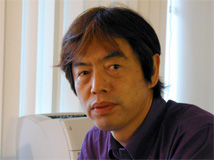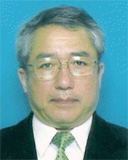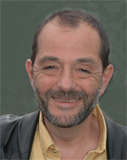Keynote and Invited TalksRyohei NakatsuKwansei Gakuin University, JapanA New Framework for Entertainment Computing: from Passive to Active ExperienceA new framework for entertainment computing is introduced and discussed. Based on already existing models and concepts the different links and relationships between enjoyment, flow, presence, and different forms of experiences are shown and their contributions to the new framework reviewed. To address the more fundamental and theoretical issues regarding entertainment, we have to utilize existing theories in information processing, enjoyment and flow theory. Some already possible and probably important conclusions for the design of new entertainment system are drawn.
Ryohei Nakatsu received the B.S., M.S. and Ph.D. degrees in electronic engineering from Kyoto University in 1969, 1971 and 1982 respectively. After joining NTT in 1971, he mainly worked on speech recognition technology. In 1994, he joined ATR (Advanced Telecommunications Research Institute) as the president of ATR Media Integration & Communications Research Laboratories. From the spring of 2002 he is a professor at School of Science and Technology, Kwansei Gakuin University. At the same time he established a venture company, Nirvana Technology Inc., and became a president of the company. His research interest includes nonverbal information processing, nonverbal communications, and communication robot/agent. In 1978, he received Young Engineer Award from the Institute of Electronics, Information and Communication Engineers Japan (IEICE-J). In 1996, the best paper award from the IEEE International Conference on Multimedia. In 1999, 2000 and 2001, Telecom System Award from Telecommunication System Foundation and the best paper award from Virtual Reality Society of Japan. In 2000, the best paper award from Artificial Intelligence Society of Japan. He is a fellow of the IEEE and the Institute of Electronics, Information and Communication Engineers Japan (IEICE-J). Tetsuji BabaNamco Limited, JapanThe Existing State and Trend of Japanese Game Industry & Game TechnologyI explain the existing state and trend of Japanese game industry, especially regarding consumer game such as console game, online game and cellar phone game including the subjects to be solved by game productions. Next I explain the topics of Japanese game technology to contribute to the discrimination against other game productions and to inspire the market of consumer game. In addition to the explanation of the existing state and trend of Japanese game industry and game technology I show some actual examples of NAMCO's game technologies using image recognition technology, fluid dynamics and so on.
Tetsuji Baba is the team leader of Virtual Tech Laboratories at Namco Limited. He graduated from Naval Architecture Division, School of Engineering at Osaka University in 1972 and completed his master's program at the graduated school in 1974. He joined Namco Limited in 1995. He engages in the research and development of video game related to CG technology, image recognition technology, real time physical simulation technology, autostereoscopic display technology etc. Stephane NatkinCNAM, FranceFrom Games and to Digital Entertainments and Media in the XXI centuryFrom a cultural point of view, one of the main aspects of the last century is the development of communication networks: telephone, radio, television. The consequences of this development are tremendous. From an individual point of view, our use of communications has completely changed. From a worldwide point of view, the omnipresence of broadcast media and more generally of mass media, leaded to a cross influence between culture and the predominance of the US way of life. At the end of the century, the growth of the Internet Network suggests a new communication revolution relying on interactive media. But, which type of sociological relations and which type of new contents will be induced by interactive networks?
One way to understand this evolution is to consider the increasingly complex relationships between
the real world and the virtual world, in multiplayer games and more generally in entertainment
applications.
From a technical point of view new concepts and devices are changing the scene. We think about mobile and ubiquitous computing, tangible interfaces, smart devices…The next generation media will rely on the cross media uniform platform. The principle is rather simple: the user may interact with the same interactive virtual world using all of the possible devices: home cinema, computers, interactive TV sets, PDA, mobile phone… The media interface will be automatically adapted to the device. A rather simple (and poor) vision of this platform is the automatic transformation of a web page from a computer interface to a mobile phone one. A much more advanced understanding of the unified platform can be forecast in terms of possible contents and in particular the next generation of games. The most advanced feature of the uniform platform is the ability to mix broadcast passive media and active media into a unified medium. More generally these examples foresee the development of a new generation of interactive media using both reality and virtuality in a complex mixed mode. The MMOG "Mogi" in the city of Tokyo or "Botfighters2" in the city of Beijing are good examples of this evolution. They are both location-based mobile multiplayer games. Botfighters2, it is a location-based action FPS MMOG. The player has to attack other players with his mobile phone while moving in the streets of the real town, stealing secret information, destroying the enemy's virtual installations. Both games use the positions of the players in the landscape and the landscape itself to generate the play. The main interface is the phone, but some actions can be performed on a standard PC through the Internet and the evolution of the game is presented on the television. In this talk we will show several example and demonstration of this evolution and analyze its impact both from the point of view of media and video games. As a consequence, in the next ten years, the video games world may change significantly in its content, its technology and its economy.
Stéphane Natkin is professor in the department of Computer Science, and a member of the administrative board at the Conservatoire National des Arts et Métiers (CNAM) in Paris France. He is at the head of the French High School on Games and Interactive Media (ENJMIN) and the director of Computer Research Laboratory. He teaches in particular Computer Games principles and Multimedia Systems. He has worked in the field multimedia systems, video games and critical computer system and both from the research and the industrial point of view and is the author of numerous publications and communications in these fields. He act, as a scientific advisor, for France Telecom R&D for research programs related to entertainments and games. He is the founder of a security software editor and he was also the manager of an art gallery located in the centre of Paris. He is the author of the books "Internet Security Protocols" DUNOD 2001 and “Computer Games and Media in the XXI century” Vuibert 2004; and “Understanding the future of media though video games”, to appear, AKPeters, 2006. Roy AscottUniversity of Plymouth, EnglandSyncretic Reality and the Technoetic UniverseThe convergence of silicon-dry computational systems and wet biological processes provides new media for all creative fields. The human mind and telematic systems are interacting to produce a new sense of self and planetary consciousness. Immaterial connectedness defines both quantum reality and the spiritual domain. The biophotonic information network of the body can be seen to parallel the telematic flows of electrons and photons across the planet. From this ontological horizon, certain questions arise: Are we developing a syncretic reality that merges mixed reality technology, altered states of consciousness, and conflicting models of reality governed by metaphors of biology, quantum physics, language and social habit? Is our drive to created wider and deeper and faster networks an evolutionary impulse to engage more fully with universal mind? Does the telematic field of cyberception attempt to mirror or even augment our awareness of the field of consciousness? Are there teleological promptings and purposive impulses in our own DNA? Is our interest in the hybridization of forms related to an emergent hybridization of space? Are online gaming and other instruments of digital entertainment merely ephemeral distractions or might they contribute to processes of world-building and planetary consciousness that political strategies cannot reach? These questions are compounded by what we do not know about dark matter and dark energy, the location of mind, the nature of qualia, purpose in evolutionary processes; the complexity of energy fields. Syncretism, well recognised historically as an attempt to reconcile and analogise disparate religious beliefs and cultural practices - seeking likeness within unlike things - may now serve us in understanding the multi-layered world views, both material and metaphysical, that are emerging from our engagement with pervasive computational technologies and post-biological systems.
Roy Ascott is president of the Planetary Collegium, and Professor of Technoetic Arts in the University of Plymouth, England and Adjunct Professor in Design|Media Arts at the University of California Los Angeles. He is internationally recognised as the pioneer of telematic art and as a seminal theorist in the field of new media. His research is in art and the technology of consciousness. He edits Technoetic Arts: a journal of speculative research (Intellect Books, UK), and is an honorary editor of Leonardo (MIT Press), and other refereed journals. He has advised new media art centres and festivals in the UK and Europe, Japan, North and South America, and Korea, as well as for the CEC and UNESCO, and was international commissioner of the first comprehensive exhibition of digital art of the Venice Biennale. He convenes the annual international Consciousness Reframed conferences. His books include: Engineering Nature. Bristol: Intellect Books, 2005;Telematic Embrace: Visionary Theories of Art Technology and Consciousness. Berkeley: University of California Press, 2003; and in Japanese - Art & Telematics: toward the Construction of New Aesthetics. (trans. & ed. E. Fujihara). Tokyo: NTT Publishing, 1998. |
|||



